GEEKOM A5 mini-PC Review: Affordable Cezanne Zen 3 at 35W
by Ganesh T S on December 8, 2023 9:15 AM ESTWorkstation Performance - SPECworkstation 3.1
SFF PCs traditionally do not lend themselves to workstation duties. However, a recent trend towards miniaturized workstations has been observed. While systems in the GEEKOM A5's form-factor are still not capable enough to become workstations, the rapid performance improvements over the years has encouraged us to benchmark some of these UCFF / SFF systems for content creation workloads and professional applications. Towards this, we processed the SPECworkstation 3.1 benchmark from SPEC.
The SPECworkstation 3.1 benchmark measures workstation performance based on a number of professional applications. It includes more than 140 tests based on 30 different workloads that exercise the CPU, graphics, I/O and memory hierarchy. These workloads fall into different categories.
- Media and Entertainment (3D animation, rendering)
- Product Development (CAD/CAM/CAE)
- Life Sciences (medical, molecular)
- Financial Services
- Energy (oil and gas)
- General Operations
- GPU Compute
Individual scores are generated for each test and a composite score for each category is calculated based on a reference machine (HP Z240 tower workstation using an Intel E3-1240 v5 CPU, an AMD Radeon Pro WX3100 GPU, 16GB of DDR4-2133, and a SanDisk 512GB SSD). Official benchmark results generated automatically by the benchmark itself are linked in the table below for the systems being compared.
| SPECworkstation 3.1 Official Results (2K) | |
| GEEKOM A5 | Run Summary |
| ASRock 4X4 BOX-5800U (Performance) | Run Summary |
| Intel NUC11PAQi7 (Panther Canyon) | Run Summary |
| ASRock NUC BOX-1360P-D5 (Performance) | Run Summary |
| ASRock 4X4 BOX-7735U (Performance) | Run Summary |
| ASUS PN50 | Run Summary |
| Intel NUC13ANKi7 (Arena Canyon) | Run Summary |
| ASRock NUCS BOX-1360P-D4 | Run Summary |
| ASRock NUC BOX-N97 | Run Summary |
| ASRock 4X4 BOX-4800U | Run Summary |
| ASUS PN51-E1 | Run Summary |
| Intel NUC12WSKi7 (Wall Street Canyon) | Run Summary |
| GEEKOM AS 6 (ASUS PN53) | Run Summary |
Details of the tests in each category, as well as an overall comparison of the systems on a per-category basis are presented below.
Media and Entertainment
The Media and Entertainment category comprises of workloads from five distinct applications:
- The Blender workload measures system performance for content creation using the open-source Blender application. Tests include rendering of scenes of varying complexity using the OpenGL and ray-tracing renderers.
- The Handbrake workload uses the open-source Handbrake application to transcode a 4K H.264 file into a H.265 file at 4K and 2K resolutions using the CPU capabilities alone.
- The LuxRender workload benchmarks the LuxCore physically based renderer using LuxMark.
- The Maya workload uses the SPECviewperf 13 maya-05 viewset to replay traces generated using the Autodesk Maya 2017 application for 3D animation.
- The 3ds Max workload uses the SPECviewperf 13 3dsmax-06 viewset to replay traces generated by Autodesk's 3ds Max 2016 using the default Nitrous DX11 driver. The workload represents system usage for 3D modeling tasks.
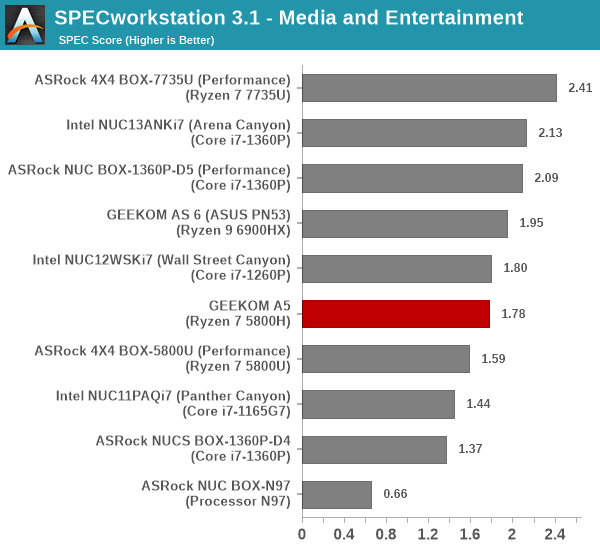
Product Development
The Product Development category comprises of eight distinct workloads:
- The Rodinia (CFD) workload benchmarks a computational fluid dynamics (CFD) algorithm.
- The WPCcfd workload benchmarks another CFD algorithm involving combustion and turbulence modeling.
- The CalculiX workload uses the Calculix finite-element analysis program to model a jet engine turbine's internal temperature.
- The Catia workload uses the catia-05 viewset from SPECviewperf 13 to replay traces generated by Dassault Systemes' CATIA V6 R2012 3D CAD application.
- The Creo workload uses the creo-02 viewset from SPECviewperf 13 to replay traces generated by PTC's Creo, a 3D CAD application.
- The NX workload uses the snx-03 viewset from SPECviewperf 13 to replay traces generated by the Siemens PLM NX 8.0 CAD/CAM/CAE application.
- The Solidworks workload uses the sw-04 viewset from SPECviewperf 13 to replay traces generated by Dassault Systemes' SolidWorks 2013 SP1 CAD/CAE application.
- The Showcase workload uses the showcase-02 viewset from SPECviewperf 13 to replay traces from Autodesk's Showcase 2013 3D visualization and presentation application
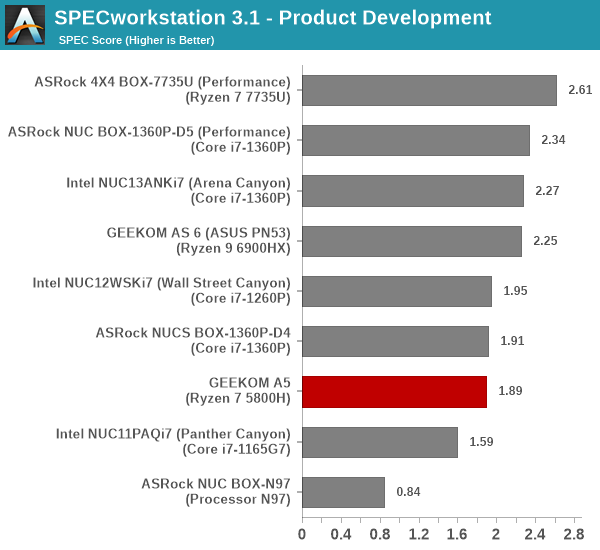
Life Sciences
The Life Sciences category comprises of four distinct test sets:
- The LAMMPS set comprises of five tests simulating different molecular properties using the LAMMPS molecular dynamics simulator.
- The NAMD set comprises of three tests simulating different molecular interactions.
- The Rodinia (Life Sciences) set comprises of four tests - the Heartwall medical imaging algorithm, the Lavamd algorithm for calculation of particle potential and relocation in a 3D space due to mutual forces, the Hotspot algorithm to estimate processor temperature with thermal simulations, and the SRAD anisotropic diffusion algorithm for denoising.
- The Medical workload uses the medical-02 viewset from SPECviewperf 13 to determine system performance for the Tuvok rendering core in the ImageVis3D volume visualization program.
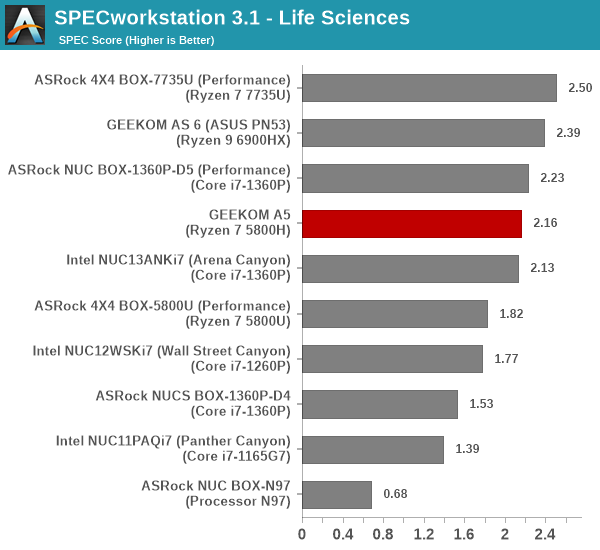
Financial Services
The Financial Services workload set benchmarks the system for three popular algorithms used in the financial services industry - the Monte Carlo probability simulation for risk assessment and forecast modeling, the Black-Scholes pricing model, and the Binomial Options pricing model.
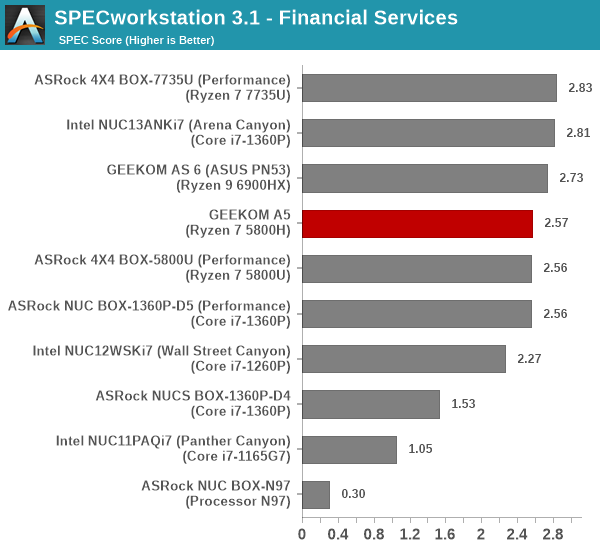
Energy
The Energy category comprises of workloads simulating various algorithms used in the oil and gas industry:
- The FFTW workload computes discrete Fourier transforms of large matrices.
- The Convolution workload computes the convolution of a random 100x100 filter on a 400 megapixel image.
- The SRMP workload processes the Surface-Related Multiples Prediction algorithm used in seismic data processing.
- The Kirchhoff Migration workload processes an algorithm to calculate the back propogation of a seismic wavefield.
- The Poisson workload takes advantage of the OpenMP multi-processing framework to solve the Poisson's equation.
- The Energy workload uses the energy-02 viewset from SPECviewperf 13 to determine system performance for the open-source OPendTec seismic visualization application.
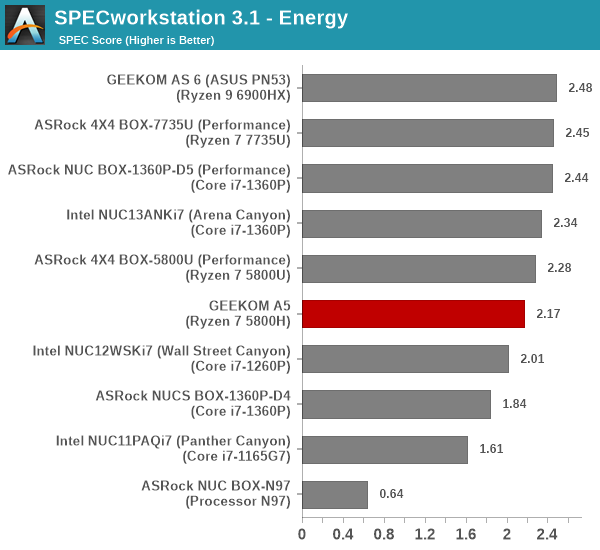
General Operations
In the General Options category, the focus is on workloads from widely used applications in the workstation market:
- The 7zip workload represents compression and decompression operations using the open-source 7zip file archiver program.
- The Python workload benchmarks math operations using the numpy and scipy libraries along with other Python features.
- The Octave workload performs math operations using the Octave programming language used in scientific computing.
- The Storage workload evaluates the performance of the underlying storage device using transaction traces from multiple workstation applications.
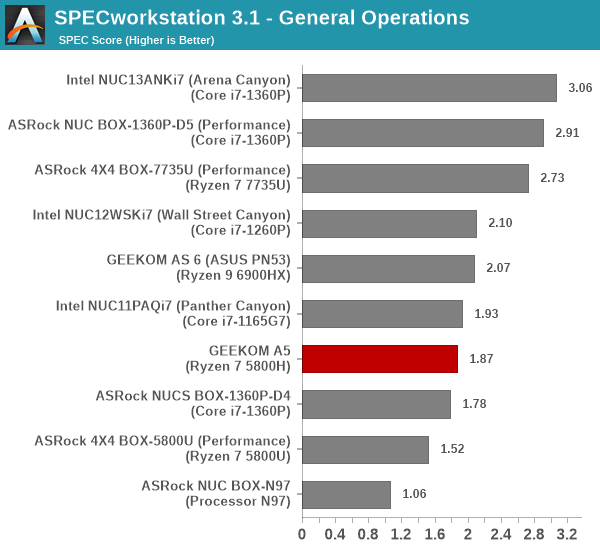
GPU Compute
In the GPU Compute category, the focus is on workloads taking advantage of the GPU compute capabilities using either OpenCL or CUDA, as applicable:
- The LuxRender benchmark is the same as the one seen in the media and entertainment category.
- The Caffe benchmark measures the performance of the Caffe deep-learning framework.
- The Folding@Home benchmark measures the performance of the system for distributed computing workloads focused on tasks such as protein folding and drug design.
We only process the OpenCL variants of the benchmark, as the CUDA version doesn't process correctly with default driver installs.
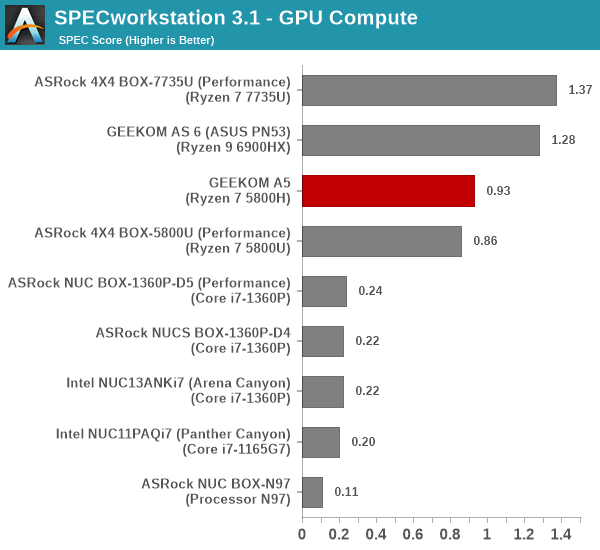
Workloads processed on workstations are long-running tasks that don't benefit in any meaningful way from short bursts of higher power. UCFF systems find it difficult to sustain these higher package power numbers for a long enough time to influence the performance in workstation benchmarks. As a result, the relative performance of the GEEKOM A5 in SPECviewperf v3.1 is dictated by its sustained package power limit of 35W. In all the workloads, the system tends to appear in the middle of the pack, closely tracking the other Cezanne-based system in the comparison list.










35 Comments
View All Comments
t.s - Friday, December 15, 2023 - link
Yes. Inferior, yet pricier than AMD counterpart.sjkpublic@gmail.com - Saturday, December 9, 2023 - link
All I see here is outdated hardware. Gen3 and not Gen4 or better. No USB 4. Etc. Great unit if you are placing it in a Mall display.FWhitTrampoline - Sunday, December 10, 2023 - link
An ASRock X300 Desk Mini with an STX/AM4 MB and Ryzen 5700G can be had for a little over $320 and the X300 Desk Mini comes with 2, M.2 x4 PCIe link slots and space for 2 SATA internal SSDs. And one of the M.2 slots can be fitted with an M.2 to OCuLink adapter and there's plenty of Knockouts on the X300 Desk Mini's case to rout the OCuLink cable out of the case easily sans any need to open the case afterwards. So with Knockouts on the case for an optional OEM 2 USB port kit or other knockout some OCuLink port could be retrofitted is one gets creative!Reflex - Monday, December 11, 2023 - link
As an owner of a MiniITX board with a 5700G I regret to inform you that external PCIe lanes only run at x3 with that CPU, even for storage. So while on paper that X300 looks better than this mini box, in practice it's got the same limitation. The 5700G is overall not quite as powerful as this mini box at equivalent wattages, although thanks to being an ITX sysem I run mine at 65W which likely outperforms this box substantially.FWhitTrampoline - Tuesday, December 12, 2023 - link
The M.2 PCIe Lanes on processor side of the Board is listed as PCIe 3.0 X4 lanes while the M.2 on back side of the MB limited to what's listed so not according to ASrock's specifications page for the X300 Desk Mini:- 2 x SATA 6Gb 2.5-inch 7mm/9.5mm Hard Drive (RAID 0/1)
- 1 x Ultra M.2 (2280) PCIe Gen3 x4 SSD Slot
- 1 x Ultra M.2 (2280) Slot
- PCIe Gen3 x4 (Renoir, Picasso and Raven Ridge APU)
- PCIe Gen3 x2 (Athlon 2xxGE series APU)
t.s - Friday, December 15, 2023 - link
And what Gen3 that not enough for you that you have to use Gen4? As for USB4, I agree. And you can get it if you buy mini-pc with ryzen 6800u/h or 7735H.Schugy - Sunday, December 10, 2023 - link
That non-USB-C PSU brick must be a joke.lmcd - Monday, December 11, 2023 - link
Depending on your USB controller as part of the lone source of power is an anti-feature in my opinion. With laptops it's different because there's a battery, but USB-C desktop power is a "no thanks."meacupla - Monday, December 11, 2023 - link
It's a standard, and really cheap, 19V laptop power brick.Finding a cheap USB-C charger than can output >120W over a single port is a challenge, unfortunately. Most of them top out at 100W per port.
200W and 240W PD cables have been available for at least 6 months, but no such charger has shown up yet.
stephenbrooks - Monday, December 11, 2023 - link
The brick is nearly as large as the PC.